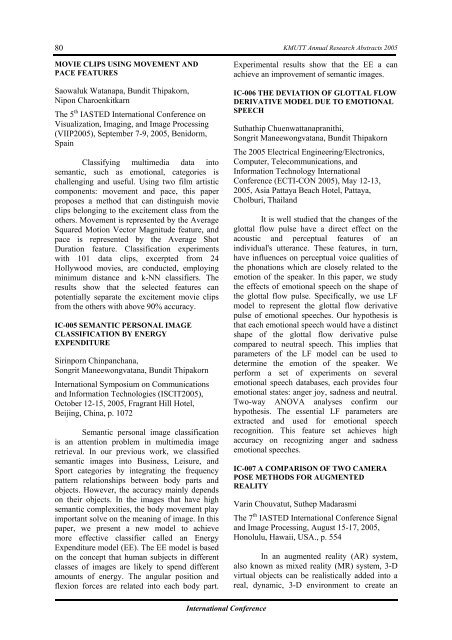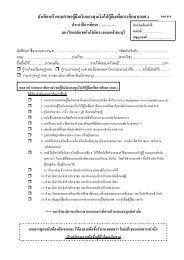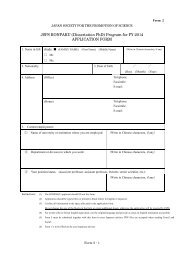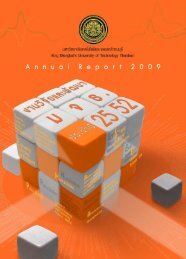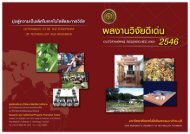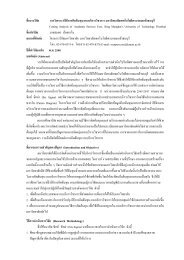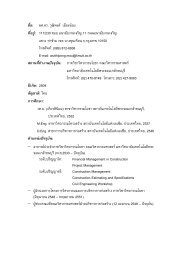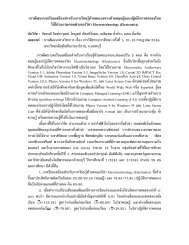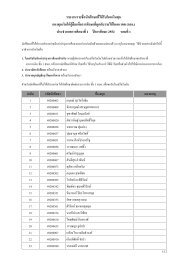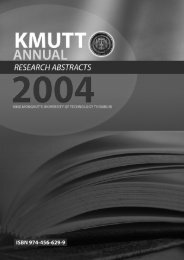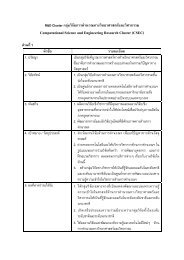You also want an ePaper? Increase the reach of your titles
YUMPU automatically turns print PDFs into web optimized ePapers that Google loves.
80<br />
MOVIE CLIPS USING MOVEMENT AND<br />
PACE FEATURES<br />
Saowaluk Watanapa, Bundit Thipakorn,<br />
Nipon Charoenkitkarn<br />
The 5 th IASTED International Conference on<br />
Visualization, Imaging, and Image Processing<br />
(VIIP2005), September 7-9, 2005, Benidorm,<br />
Spain<br />
Classifying multimedia data into<br />
semantic, such as emotional, categories is<br />
challenging and useful. Using two film artistic<br />
components: movement and pace, this paper<br />
proposes a method that can distinguish movie<br />
clips belonging to the excitement class from the<br />
others. Movement is represented by the Average<br />
Squared Motion Vector Magnitude feature, and<br />
pace is represented by the Average Shot<br />
Duration feature. Classification experiments<br />
with 101 data clips, excerpted from 24<br />
Hollywood movies, are conducted, employing<br />
minimum distance and k-NN classifiers. The<br />
results show that the selected features can<br />
potentially separate the excitement movie clips<br />
from the others with above 90% accuracy.<br />
IC-005 SEMANTIC PERSONAL IMAGE<br />
CLASSIFICATION BY ENERGY<br />
EXPENDITURE<br />
Sirinporn Chinpanchana,<br />
Songrit Maneewongvatana, Bundit Thipakorn<br />
International Symposium on Communications<br />
and Information Technologies (ISCIT2005),<br />
October 12-15, 2005, Fragrant Hill Hotel,<br />
Beijing, China, p. 1072<br />
Semantic personal image classification<br />
is an attention problem in multimedia image<br />
retrieval. In our previous work, we classified<br />
semantic images into Business, Leisure, and<br />
Sport categories by integrating the frequency<br />
pattern relationships between body parts and<br />
objects. However, the accuracy mainly depends<br />
on their objects. In the images that have high<br />
semantic complexities, the body movement play<br />
important solve on the meaning of image. In this<br />
paper, we present a new model to achieve<br />
more effective classifier called an Energy<br />
Expenditure model (EE). The EE model is based<br />
on the concept that human subjects in different<br />
classes of images are likely to spend different<br />
amounts of energy. The angular position and<br />
flexion forces are related into each body part.<br />
KMUTT Annual Research Abstracts 2005<br />
Experimental results show that the EE a can<br />
achieve an improvement of semantic images.<br />
IC-006 THE DEVIATION OF GLOTTAL FLOW<br />
DERIVATIVE MODEL DUE TO EMOTIONAL<br />
SPEECH<br />
Suthathip Chuenwattanapranithi,<br />
Songrit Maneewongvatana, Bundit Thipakorn<br />
The 2005 Electrical Engineering/Electronics,<br />
Computer, Telecommunications, and<br />
Information Technology International<br />
Conference (ECTI-CON 2005), May 12-13,<br />
2005, Asia Pattaya Beach Hotel, Pattaya,<br />
Cholburi, Thailand<br />
It is well studied that the changes of the<br />
glottal flow pulse have a direct effect on the<br />
acoustic and perceptual features of an<br />
individual's utterance. These features, in turn,<br />
have influences on perceptual voice qualities of<br />
the phonations which are closely related to the<br />
emotion of the speaker. In this paper, we study<br />
the effects of emotional speech on the shape of<br />
the glottal flow pulse. Specifically, we use LF<br />
model to represent the glottal flow derivative<br />
pulse of emotional speeches. Our hypothesis is<br />
that each emotional speech would have a distinct<br />
shape of the glottal flow derivative pulse<br />
compared to neutral speech. This implies that<br />
parameters of the LF model can be used to<br />
determine the emotion of the speaker. We<br />
perform a set of experiments on several<br />
emotional speech databases, each provides four<br />
emotional states: anger joy, sadness and neutral.<br />
Two-way ANOVA analyses confirm our<br />
hypothesis. The essential LF parameters are<br />
extracted and used for emotional speech<br />
recognition. This feature set achieves high<br />
accuracy on recognizing anger and sadness<br />
emotional speeches.<br />
IC-007 A COMPARISON OF TWO CAMERA<br />
POSE METHODS FOR AUGMENTED<br />
REALITY<br />
Varin Chouvatut, Suthep Madarasmi<br />
The 7 th IASTED International Conference Signal<br />
and Image Processing, August 15-17, 2005,<br />
Honolulu, Hawaii, USA., p. 554<br />
In an augmented reality (AR) system,<br />
also known as mixed reality (MR) system, 3-D<br />
virtual objects can be realistically added into a<br />
real, dynamic, 3-D environment to create an<br />
International Conference


